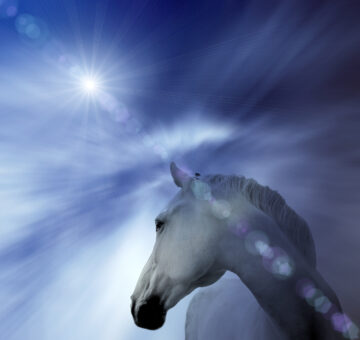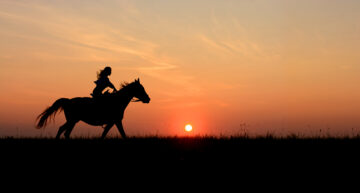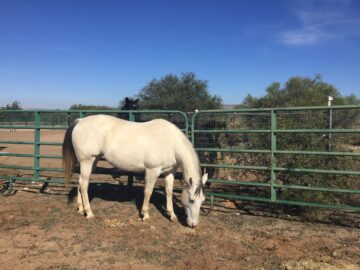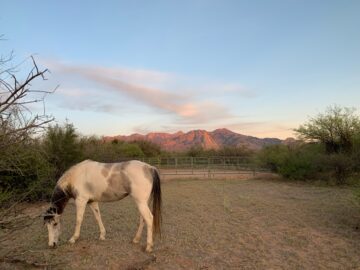
“Your body is the horse your mind rides around on. It’s a sentient being, not a machine. When we form a partnership with the body, it becomes an immense source of wisdom and creativity, offering innovative approaches to life that the socially conditioned, logical brain could never fathom on its own. This hidden wisdom is key to success and fulfillment, helping us move beyond trauma, perfectionism, and self-doubt into deep connection with life and all the sentient beings who share this earthly journey with us.” — Linda Kohanov
In this edition of Eponaquest News, author and founder Linda Kohanov shares an extended excerpt from the revised and expanded edition of her bestselling book The Tao of Equus, released in June 2024.
“This is one example of a new anecdote I was able to articulate in the re-write,” Linda says. “It offers a window into how an equine-facilitated learning session can help even seasoned professionals uncover unconscious blocks and gently face issues that keep them from reaching their full potential. You’ll see, in detail, how I assist an accomplished woman in accessing the wisdom of her body to change old patterns and behaviors she didn’t even know she had. It illustrates how the process I use helps people titrate the experience so that they don’t become overwhelmed. The excerpt also outlines how this self-awareness technique offers a modern take on the Buddha’s Four Foundations of Mindfulness. And it illustrates how seemingly simple activities with horses on the ground can have life-changing implications. I hope you enjoy it!”
The following is an excerpt from the new version of the Tao of Equus.
The Promise of Freedom
As I adapted a number of intuitive communication and mindfulness practices to the riding arena, I realized how talented horses were in teaching the skills usually associated with meditation. In 1999, I developed what later became an international program to teach life-enhancement skills to riders and nonriders alike. These private or group lessons and workshops draw on mindfulness practices and stress reduction, intuitive communication, leadership, and emotional/social intelligence skills from a variety of traditions without promoting a particular religion or belief system. I chose methods for their affinity with the natural wisdom of the horse and their proven effectiveness in helping people reach higher consciousness and greater fulfillment in life and work. Starting with the first session, students learn to assess their own physical, emotional, mental, and energetic states from moment to moment. While this multilevel awareness is crucial to safe, productive interactions with horses, it’s also the same ability taught through the Buddha’s Four Foundations of Mindfulness: mindfulness of the body (in which breathing and bodily sensations become the objects of meditation), mindfulness of feelings (meditation on the pleasant and unpleasant aspects of bodily experience), mindfulness of thought and emotions (observing how much our routine thought patterns are rooted in the repression of uncomfortable emotions), and, finally, mindfulness of mind (in which we reach a nonhabitual state of clarity, free from projection, avoidance, or attachment).
These steps toward greater peace and self-knowledge require considerable fortitude in the sitting, standing, or walking postures associated with traditional forms of meditation. Many people lose interest when they reach an impasse that requires changes in attitudes and behaviors so ingrained they’re barely detectable. Horses quite naturally bring these issues to the surface, mirroring difficulties that other human beings might not notice. These animals act as highly sensitive biofeedback agents for students, facilitating breakthroughs that allow people to move forward in their mindfulness practices, in their equestrian pursuits, in their interactions with others, and, perhaps most importantly, in their relationship with themselves.

I’m constantly inspired by the many ways that horses and people uplift one another when the humans embrace past traumas and unexpected challenges thoughtfully and compassionately. Those obsessed with performance and perfection try to hide their wounds, tears, and uncertainties, yet wearing a mask of confidence and well-being creates disconnection, making it difficult to access internal psychological and physiological resources for healing, restoration, and growth. Paradoxically, acknowledging our “imperfections” opens us to a wider view of our potential, to the love and acceptance available to us all. The universe no longer feels cold, cruel, and exacting but filled with adventures designed to expand consciousness and connection. Still, what psychologist and author Marion Woodman called an “addiction to perfection” is one of the most common issues I encounter with high functioning clients who attend workshops designed to help people excel in life.

The first time I met “Janelle,” I was most certainly impressed. Tall, slim, graceful, almost regal, she had the optimal conformation for riding. And indeed she often won high-level horse dressage and hunter jumper classes. She brought one her students to a workshop covering leadership, nonverbal communication, mindfulness, and emotional/social intelligence skills. I could tell “Amber” thought the world of her teacher, for good reason. Janelle was that rare riding instructor interested in a holistic approach beyond herbal supplements and chiropractic care, one that included the mental, emotional, and spiritual aspects of the horse-human connection. It was no stretch for her to treat the animals as sentient beings worthy of respect and collaboration. After teaching some mind-body awareness tools, self-regulation/coregulation skills, and protocols for mutual respect, I invited participants to put all those pieces together on day two of a four-day workshop through an activity called Exploring Connection. Many people have deeply moving and insightful experiences during these interactions with a loose horse. As an experienced trainer, Janelle had spent thousands of hours with the animals, so I figured it would be a piece of cake for her. In fact, I hoped she wouldn’t be bored. So when it was her turn, I was surprised at how stressed she looked.
Part of the process involves leading people through a body scan that is quite a bit different from the ways people normally interact with somatic information. By consciously connecting with and naming sensations occurring in the moment, clients become aware of postures, areas of tension and relaxation, heart rate, breathing, and so forth — nonverbal cues that most participants ignore or try to fix without understanding the meaning behind them. This multifaceted protocol coincides with three of the Buddha’s Four Foundations of Mindfulness: mindfulness of the body, mindfulness of feelings, and, quite often mindfulness of thoughts and emotions. It’s also incredibly practical for riders and trainers in all disciplines.
With only 10 percent of human communication in the verbal range, many people are completely unaware of what they’re conveying to horses through that other 90 percent. For instance, the body scan helps an equestrian realize that she’s collapsing and leaning back when she thinks she’s actin assertively. When a person unconsciously assumes this submissive stance, just about any horse will move into her space, no matter how stern her voice becomes. Beyond the mindfulness aspects of the tool, the body scan also offers a technique for getting information from sensations. The key is not to relax out of the feeling or try to become grounded right away, but to focus on a posture or area of tension, sending it oxygen, awareness, and curiosity while asking for one message at a time. This is counterintuitive for most people, especially massage therapists, chiropractors, yoga instructors, and equestrians who are used to making adjustments in response to pain or in relation to postures that are not considered optimal for the task at hand.
Because emotions and sensations are contagious, we also use the scan to help people learn how to differentiate between what they’re feeling and what others are feeling. For this reason, I had Janelle stand with her back to the horse to check in with her own body before turning around and exploring connection with her equine partner.
Janelle’s face was pale, her jaw tight, her shoulders bunched up to her neck. She looked like she wanted to run. Without drawing attention to what I was doing, I shifted my breathing to coregulate her nervous system, not to encourage her to relax out of what she was experiencing but to nonverbally help her avoid panic and stay present long enough to decipher what her body was so obviously worried about. This also kept me from catching her tension, allowing me to adopt facial expressions and a vocal tone conveying authentic curiosity and support.
Janelle described a variety of chaotic sensations during her initial scan. I asked her to pick the one that stood out to her the most. Her hands immediately clasped her neck.
“It seems like there’s a lot going on in your neck,” I acknowledged, “but I want you to make a deal with your body: tell it you’ll listen to what it wants to say, but only if it releases the information one piece at a time. Like when you have a corral full of feisty horses. You halter the one closest to the gate and take one horse out at a time. You don’t open the paddock and let them all run over you.”
I suggested that she imagine breathing into the cacophony of sensations in her neck without trying to change anything, visualizing that a light in her conscious mind was following that breath, illuminating her neck. “It’s like creating an email connection between your thinking brain and your neck,” I explained. “Ask for one piece of information and be open to how your body might speak to you. It may send you a color, an image, a memory, a cliche, a completely irrational phrase, or even a fragment of a song. The message may not make sense right away, because the body tends to speak more like an artist or a poet than a scientist. Just tell me the first thing that comes to your mind.”
The act of breathing into a sensation is a form of creative visualization with a self-regulation component, allowing people to coax their nervous system toward a more centered state while interacting with the body as a source of intelligence. It conveys curiosity and acceptance of the body’s concerns instead of enacting rigid attempts to force the body into suppression and compliance.
Janelle closed her eyes and let her hands drop to her sides. “I don’t know,” she said after a few moments of deep breathing. “I’m not getting anything. It just feels like a vice around my neck getting tighter.”
“The image of a vice is the message,” I assured her. “Great. Now, most people at this point would be tempted to find a way to release the vice, to get rid of it and relax. But over the years, I’ve learned it’s more productive to find out why it’s there first. So I invite you to breathe into the sensation again and ask, ‘What is the purpose of the vice?’”
Janelle concentrated silently for a moment and then opened her eyes thoughtfully, like it suddenly made perfect sense to her. “It’s there to hold feelings and information down. It seems to be suppressing stuff my brain doesn’t want to deal with.”
I asked Janelle to check back in with the sensation in her neck, to see if it had changed in some way.
“Yes,” she marveled. “It relaxed slightly, like it was satisfied that I was finally listening to it. Strange.”
“Horses will sigh and lower their heads when a person becomes congruent even if the emotion is still there,” I reminded her. “The body does the same thing. Your body is the horse your mind rides around on. It’s a sentient being, not a machine. Of course, you can beat it into submission, ride it hard, and put it away wet, but you and I both know that cooperation with the horse is much more effective.”
Janelle nodded pensively.
“You can either ask for another message or you can just move forward,” I offered. “The deal we made was to get one piece of information at a time. It’s not necessary to solve every last issue you’ve been suppressing to move forward with your day. It’s important that the body learns how to titrate the information, to bring it forward in small pieces, so we don’t get our circuits blown.”
Looking more thoughtful, Janelle wanted to see if the vice would let just one feeling through without overwhelming her with all the material she had been holding down for years. “But which one should I choose?”
“Remember the corral of horses?” I asked. “If the herd is racing around, you don’t jump in and try to grab the rearing stallion at the back. Just imagine picking the message closest to surface, the horse closest to the gate, so to speak.”
Janelle closed her eyes, concentrating. “The feeling is fear.”
“What’s the concern?” I asked.
“Jeez, I don’t know. I think it might be . . .”
“Don’t think,” I said. “Go back to your body. Let it speak. Breathe into the sensation and ask, ‘What’s the concern?’”
“Rejection,” she said emphatically, her eyes widening with surprise. “Wow, I really didn’t expect that.”
I reminded this supremely experienced horsewoman that the goal of the exercise was not achieving connection but exploring connection. “There is no right or wrong here. We are interested in when you start to feel connected and if the horse’s behavior changes in some way. Maybe the horse will walk over to you, or follow you, or allow you to approach and pet her. Maybe something in the environment will suddenly attract her attention away from you, and you’ll discover a new way to regain the connection.”
Janelle nodded tentatively. I directed the much more centered woman to stay in contact with her body as she turned toward the mare. “Does anything change in your body when you look at Blanca?”
“I feel much more relaxed,” she replied.
“Just for fun, let’s continue the conversation with your body. As I say the goal out loud, notice where it’s activated in your body or simply where your attention is drawn. The goal is to explore connection with Blanca.”
“My heart,” she said confidently after a moment of concentration.
“Breathe into your heart, creating that mind-body connection,” I said. “Ask what advice your body has for exploring connection with Blanca today.”

“Breathe and be,” she replied. Janelle opened her eyes with a quizzical look. “Wow, I don’t think I would have come up with that. I would have tried something more active.”
“Well, see what happens if you just go in there and follow your body’s advice. In this way, we are inviting your ‘horse,’ the one your mind rides, to have a say, to share its wisdom.”
Janelle liked that idea. Upon entering the corral, she barely took two steps before Blanca turned and walked up to her. The woman rested her right hand gently on the gray mare’s shoulder. I could see her breathing deeply and evenly. A minute or two later, Blanca’s daughter Cloud, who had been nibbling fallen mesquite leaves in an adjoining corral, lifted her head as if she’d heard someone offering carrots and made a beeline toward Janelle. (Remember, previous research I’d undertaken with Dr. Ann Baldwin shows that horses can sense, at a distance of 20 to 30 feet or more when a person shifts into a more regulated physiological and psychological state. They often register this shift by walking up to the person and standing quietly with them.) Without having to adjust her position, Janelle reached her left arm through the fence and was able to rest this other hand on Cloud’s soft neck. The three of them stood silently for ten minutes, breathing and being, in what looked to those of us watching outside like a timeless experience of profound connection. A feeling of ecstasy seemed to expand outward in concentric waves, opening the hearts and expanding the minds of everyone witnessing the quiet yet riveting event.

We all had tears in our eyes as Janelle emerged, sat down with the group, and let out a long, pensive sigh. It took her a moment to speak.
“When I was in there, I understood more about that feeling of fear,” she said. “It wasn’t about being embarrassed if I failed to connect. It was much more dire than that. I was deeply afraid of a soul-level rejection.”
Janelle explained that Blanca and Cloud helped her realize that she somehow unconsciously believed that she would receive love in direct proportion to how much she excelled — in school, in sports, and in the equestrian arts.
“I don’t know where I got that idea, really. My family was always supportive. But I guess it’s something implied in our culture. My parents’ and teachers’ eyes would light up when I got straight A’s, or won an award, or brought another first place trophy home from a major competition. I guess I never conceived what it would feel like to be loved and accepted for just, well, being me. Cloud and Blanca gave me a gift that no one had ever been able to give me before. I feel more solid somehow and at the same time, lighter, happier, free.”
Janelle articulated a dilemma everyone in the group related to: appreciating others as soulful beings, outside the realm of practicality and achievement, is a challenge for modern humans, whether they’re buying a horse as a show prospect or finding their own self-worth, daily, among members of their own kind.
Copyright 2024, by Linda Kohanov from the revised edition of The Tao of Equus, Woman’s Journey of Healing and Transformation through The Way of the Horse.
Fall Workshops Filling Fast
Due to the publication of the new version of The Tao of Equus, fall, winter, and spring workshops are filling fast. Check out the offerings at www.eponaquest.com
For more information, contact the Eponaquest Office at info@eponaquest.com or 520-455-5908.
Linda also teaches the body scan and other innovative principles and techniques in her online courses, available at https://lindakohanov.com (Connections 101 offers more detail on the body scan, and other nervous system regulation techniques discussed in the excerpt featured in this newsletter.) In honor of the book’s release, you can receive 20 percent off Linda’s online courses by entering the code 20FREEDOM at checkout.